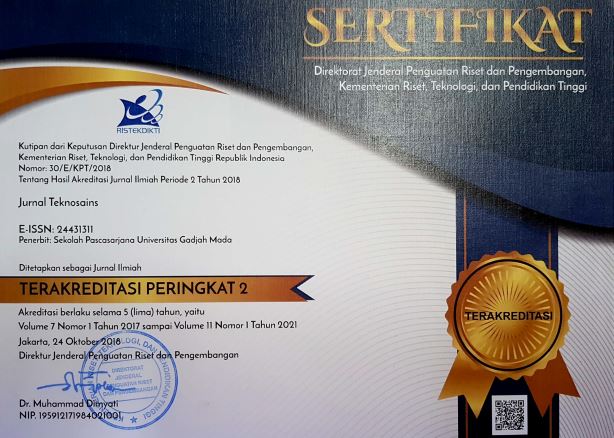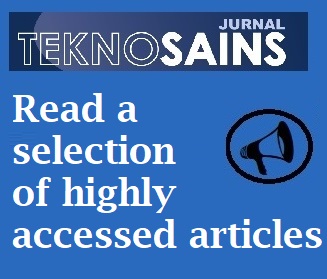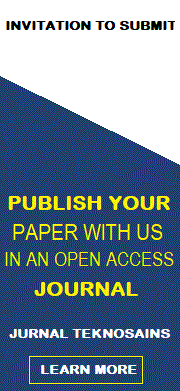- Focus and Scope
- Section Policies
- Peer Review Process
- Publication Frequency
- Open Access Policy
- Archiving
- Publication Ethics
- Screening for Plagiarism
- Publication Frequency
- Digital Archiving
- Statistic Download Article
- Statement of Originality Form
Focus and Scope
Jurnal Teknosains is a peer-reviewed journal that has been in publication since 2011, issuing volumes twice a year in June and December. Jurnal Teknosains spans the fields of Biomedical engineering, with a focus on the integration of engineering tools in biomedical applications. Our journal serves as a platform for scientific discourse in the fields of engineering, science, and technology. The journal's primary goal is to advance research in the study of science and technology, with a particular emphasis on the application of engineering principles in biomedical contexts.
The scope of Jurnal Teknosains focuses on Biomedical Engineering, where engineering serves as a critical tool in advancing healthcare. In addition to biomedical topics, the journal welcomes interdisciplinary research in related fields such as:
- Mechanical Engineering: Design and optimize biomedical devices.
- Industrial Engineering: Streamline healthcare systems and processes.
- Chemical Engineering: Develop biomaterials and drug delivery.
- Nuclear and Physical Engineering: Apply radiation for diagnostics and treatment.
- Medical Sciences: Study human body, disease, healthcare.
- Medical Imaging: Develop technologies for diagnostic visualization.
- Biotechnology, especially in relation to engineer biological systems for healthcare applications.
Jurnal Teknosains seeks to encourage innovative research that integrates engineering with biological and medical challenges, while also remaining open to relevant advancements across the engineering spectrum.
Section Policies
Articles
Peer Review Process
Every article that goes to the editorial staff will be selected through Initial Review processes by Editorial Board. Then, the articles will be sent to the Mitra Bebestari/ peer reviewer and will go to the next selection by Double Blind Preview Process. After that, the articles will be returned to the authors to revise. These processes take aound 4 month for a minimum time. In the each manuscript, Mitra Bebestari/ peer reviewer will be rated from the substantial and technical aspects. Mitra Bebestari/ peer reviewer that collaboration with the Technic, geography, agro, biomedical and sains is the experts in the public area and issues around it. They were experienced in the prestigious journal management and publication that was spread around the national and abroad.
Publication Frequency
Jurnal Teknosains publishes Twice a Year, in the June and December (8 articles in each issue). We publish a timeline for processing manuscripts that will be processed in Jurnal Teknosains. We hope that the author can use a reference below when submitting manuscript to Jurnal Teknosains as the venue of your work.
FOR JUNE:
1. Delivery Time: December 1 to February 28
2. Expected review result: on May
3. Revision time (from author): May 30
4. Acceptance article time: May 30
5. Expected publication date: June 30
FOR DECEMBER:
1. Delivery Time: July 1 to September 30
2. Expected review result: on November
3. Revision time (from author): November 30
4. Acceptance article time: November 30
5. Expected publication date: December 30
Open Access Policy
This journal provides immediate open access to its content on the principle that making research freely available to the public supports a greater global exchange of knowledge. This Journal uses doubel Blind Review for the review process of articles.
Archiving
This journal utilizes the LOCKSS system to create a distributed archiving system among participating libraries and permits those libraries to create permanent archives of the journal for purposes of preservation and restoration. More...
Publication Ethics
Publication Ethics and Publication Malpractice Statement
Duties of Authors
- Reporting Standars:
Authors of reports of original research should present an accurate account of the work performed as well as an objective discussion of its significance. Underlying data should be represented accurately in the paper. A paper should contain sufficient detail and references to permit others to replicate the work. Fraudulent or knowingly inaccurate statements constitute unethical behaviour and are unacceptable. - Data Access and Retention:
Authors are asked to provide the raw data in connection with a paper for editorial review, and should be prepared to provide public access to such data (consistent with the ALPSP-STM Statement on Data and Databases), if practicable, and should in any event be prepared to retain such data for a reasonable time after publication. - Originality and Plagiaris: The authors should ensure that they have written entirely original works, and if the authors have used the work and/or words of others that this has been appropriately cited or quoted.
- Multiple, Redundant or Concurrent Publication:
An author should not in general publish manuscripts describing essentially the same research in more than one journal or primary publication. Submitting the same manuscript to more than one journal concurrently constitutes unethical publishing behaviour and is unacceptable. - Acknowledgement of Sources:
Proper acknowledgment of the work of others must always be given. Authors should cite publications that have been influential in determining the nature of the reported work. - Authorship of the Paper:
Authorship should be limited to those who have made a significant contribution to the conception, design, execution, or interpretation of the reported study. All those who have made significant contributions should be listed as co-authors. Where there are others who have participated in certain substantive aspects of the research project, they should be acknowledged or listed as contributors. The corresponding author should ensure that all appropriate co-authors and no inappropriate co-authors are included on the paper, and that all co-authors have seen and approved the final version of the paper and have agreed to its submission for publication. - Disclosure and Conflicts of Interest:
All authors should disclose in their manuscript any financial or other substantive conflict of interest that might be construed to influence the results or interpretation of their manuscript. All sources of financial support for the project should be disclosed. - Fundamental errors in published works:
When an author discovers a significant error or inaccuracy in his/her own published work, it is the author’s obligation to promptly notify the journal editor or publisher and cooperate with the editor to retract or correct the paper. - Hazards and Human or Animal Subjects:
If the work involves chemicals, procedures or equipment that have any unusual hazards inherent in their use, the author must clearly identify these in the manuscript.
Duties of Editors
- Fair Play:
An editor at any time evaluate manuscripts for their intellectual content without regard to race, gender, sexual orientation, religious belief, ethnic origin, citizenship, or political philosophy of the authors. - Confidentiality:
The editor and any editorial staff must not disclose any information about a submitted manuscript to anyone other than the corresponding author, reviewers, potential reviewers, other editorial advisers, and the publisher, as appropriate. - Disclosure and Conflicts of Interest:
Unpublished materials disclosed in a submitted manuscript must not be used in an editor's own research without the express written consent of the author. - Publication Decisions:
The editor board journal are responsible for deciding which of the articles submitted to the journal should be published. The validation of the work in question and its importance to researchers and readers must always drive such decisions. The editors may be guided by the policies of the journal's editorial board and constrained by such legal requirements as shall then be in force regarding libel, copyright infringement and plagiarism. The editors may confer with other editors or reviewers in making this decision. - Review of Manuscripts:
Editor must ensure that each manuscript is initially evaluated by the editor for originality. The editor should organize and use peer review fairly and wisely. Editors should explain their peer review processes in the information for authors and also indicate which parts of the journal are peer reviewed. Editor should use appropriate peer reviewers for papers that are considered for publication by selecting people with sufficient expertise and avoiding those with conflicts of interest.
Duties of Reviewers
- Contribution to Editorial Decisions:
Peer review assists the editor in making editorial decisions and through the editorial communications with the author may also assist the author in improving the paper. - Promptness:
Any selected referee who feels unqualified to review the research reported in a manuscript or knows that its prompt review will be impossible should notify the editor and excuse himself from the review process - Standards of Objectivity:
Reviews should be conducted objectively. Personal criticism of the author is inappropriate. Referees should express their views clearly with supporting arguments. - Confidentiality:
Any manuscripts received for review must be treated as confidential documents. They must not be shown to or discussed with others except as authorized by the editor. - Disclosure and Conflict of Interest:
Privileged information or ideas obtained through peer review must be kept confidential and not used for personal advantage. Reviewers should not consider manuscripts in which they have conflicts of interest resulting from competitive, collaborative, or other relationships or connections with any of the authors, companies, or institutions connected to the papers. - Acknowledgement of Sources:
Reviewers should identify relevant published work that has not been cited by the authors. Any statement that an observation, derivation, or argument had been previously reported should be accompanied by the relevant citation. A reviewer should also call to the editor's attention any substantial similarity or overlap between the manuscript under consideration and any other published paper of which they have personal knowledge.
This statement clarifies ethical behavior of all parties involved in the act of publishing an article in Teknosains Journal: The Journal of Science and Technology, including the authors, the editors, the peer-reviewers and the publisher (The Graduate School of Universitas Gadjah Mada).
This statement is based on COPE’s Best Practice Guidelines for Journal Editors.
Ethical Guideline for Journal Publication
The publication of an article in a peer-reviewed Teknosains Journal: The Journal of Science and Technology is an essential building block in the development of a coherent and respected network of knowledge. It is a direct reflection of the quality of the work of the authors and the institutions that support them. Peer-reviewed articles support and embody the scientific method. Therefore, it is important to agree upon standards of expected ethical behavior for all parties involved in the act of publishing: the authors, the journal editors, the peer reviewers, the publisher and the society.
The Graduate School of Universitas Gadjah Mada (GS UGM) as publisher of this Journal takes its duties of guardianship over all stages of publishing extremely seriously and we recognize our ethical and other responsibilities. We are committed to ensuring that advertising, reprint or other commercial revenue has no impact or influence on editorial decisions. In addition, GS UGM and editorial board of Teknosains Journal will assist in communications with other journals and/or publishers where this is useful and necessary.
Publication decisions
The editor in chief of Teknosains Journal: The Journal of Science and Technology is responsible for deciding which of the articles submitted to the journal should be published. The decision is based on the recommendation of the journal’s editorial board members and reviewers. The journal abides by legal requirements as shall then be in force regarding libel, copyright infringement and plagiarism. The editor confers with the editorial team and reviewers in making this decision.
Copyright and Permissions
Jurnal Teknosains provides immediate open access to its published articles, with authors retaining copyright and free to deposit their work in any repository at any time.
Non-Discrimination
The editors and reviewers evaluate manuscripts for intellectual content without regard to race, gender, sexual orientation, religious belief, ethnic origin, citizenship, and/or political philosophy of the authors.
Confidentiality
The editor, reviewers, and editorial staff must not disclose any information about a submitted manuscript to anyone other than the corresponding author, reviewers, potential reviewers, editorial team, and the publisher, as appropriate.
Disclosure and Conflicts of Interest
Unpublished materials disclosed in a submitted manuscript must not be used by any of the editorial board members and reviewers in their own research.
Duties of Reviewers
Contribution to Editorial Decisions
The journal uses double-blind review process. The reviewers advise the editor-in-chief in making the editorial decision. The editor-in-chief communicates with authors, as required, and helps them in improving quality of their research paper.
Promptness
The journal editors are committed to provide timely review to the authors. If a reviewer does not submit his/her report in a timely manner, the paper is immediately sent to another qualified reviewer.
Confidentiality
Manuscript content is treated with at most confidentiality. The journal uses double blind process. Except for the editor-in-chief, the editors and reviewers cannot discuss paper with any other person, including the authors.
Standards of Objectivity
The editors and reviewers are required to evaluate papers based on the content. The review comment must be respectful of authors. The reviewers are required to justify their decision and recommendation.
Acknowledgement of Sources
Reviewers should identify relevant published work that has not been cited by the authors. Any statement that an observation, derivation, or argument had been previously reported should be accompanied by the relevant citation. A reviewer should also call to the editor's attention any substantial similarity or overlap between the manuscript under consideration and any other published paper of which they have personal knowledge.
Disclosure and Conflict of Interest
Privileged information or ideas obtained through peer review must be kept confidential and not used for personal advantage. Reviewers should not consider manuscripts in which they have conflicts of interest resulting from competitive, collaborative, or other relationships or connections with any of the authors, companies, or institutions connected to the papers.
Duties of Authors
Reporting Standards
Authors should present an accurate account of the work performed as well as an objective discussion of its significance. Underlying data should be represented accurately in the paper. A paper should contain sufficient detail and references to permit others to replicate the work wherever possible. Fraudulent or knowingly inaccurate statements constitute unethical behavior and are unacceptable.
Data Access and Retention
Authors may be asked to provide the raw data in connection with a paper for editorial review. They should be prepared to provide such data within reasonable time.
Originality and Plagiarism
The authors should ensure that they have written entirely original works, and if the authors have used the work and/or words of others that this has been appropriately cited or quoted. Papers found with such problems are automatically rejected and authors are so advised.
Multiple, Redundant or Concurrent Publication
When a paper is submitted for possible publication, the submitting author makes a written statement that the paper has not been published not it is currently under publication with any other journal. Simultaneous submission is considered unethical and is therefore unacceptable.
Acknowledgement of Sources
Proper acknowledgment of the work of others is required. Authors must cite publications that have led to the authors’ current research.
Authorship of the Paper
Authorship should be limited to those who have made a significant contribution to the research reported in the manuscript. The corresponding author has a responsibility to keep co-authors posted with the review process. If accepted, all authors are required to give a signed statement that the research work is their original research work.
Hazards and Human or Animal Subjects
If the work involves chemicals, procedures or equipment that have any unusual hazards inherent in their use, the author must clearly identify these in the manuscript.
Disclosure and Conflicts of Interest
All authors should disclose in their manuscript any financial or other substantive conflict of interest that might be construed to influence the results or interpretation of their manuscript. All sources of financial support for the project should be disclosed.
Fundamental Errors in Published Works
When an author discovers a significant error or inaccuracy in his/her own published work, it is the author’s obligation to promptly notify the journal editor or publisher and cooperate with the editor to retract or correct the paper.
...................................................................................
Published by
Teknosains Journal
Screening for Plagiarism
ORIGINALITY AND PLAGIARISM
In publishing, Teknosains journal strongly against any case of plagiarism on its own merits. Teknosains journal commits to deterring plagiarism, including self-plagiarism.
The authors should ensure that they have written entirely original works, and if the authors have used the work and/or words of others that this has been appropriately cited or quoted. Papers found with such problems are automatically rejected and authors are so advised. Also, significant parts of the work have not been published. The author also respects entirely Author Guideline of Jurnal Teknosains regarding to the redundant, duplicate or fraudulent publication. We use Turnitin software for this screening process. We tolerate article with a similarity no more than 15%.
The Article has not been published in other media and does not contain elements of plagiarism. We recommend that the authors should use reference management software, for the example EndNote or Mendeley.
Publication Frequency
Jurnal Teknosains publishes twice in a year, December and June.
Digital Archiving
This journal utilizes the Indonesia One Search (IOS), Indonesian Scientific Journal Database (ISJD), and Indonesian Publication Index (IPI) system to create a distributed archiving system among participating libraries and permits those libraries to create permanent archives of the journal for purposes of preservation and restoration.
Statistic Download Article
Statistic download using ALM Plugin, statistic will show on every article page.
ex.https://jurnal.ugm.ac.id/teknosains/article/view/3985
Statement of Originality Form
Statement of Originality Form, which can be obtained from http://ugm.id/teknosainsbox should be submitted along with manuscripts during the submission period. Authors needs to claim that the work is original, has not been published and is not subjected to another journal.









